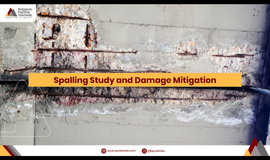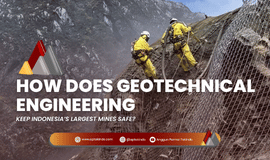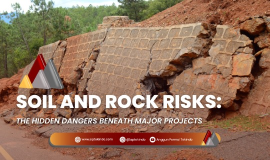When we talk about building something, it be roads, bridges, tunnels, or mining facilities, there’s one thing that often gets overlooked:
What’s underneath it all?
The answer is: rock.
In geotechnical engineering, understanding rock isn't just a bonus, it's the foundation of everything. Rock properties influence whether a structure will stand strong for decades, or face unexpected failures.
Let’s walk through some key physical properties of rock that every engineer, planner, and project owner should be aware of. Don’t worry, we’ll keep it clear and practical, not overly technical.
1️. Density: How "Heavy" Is the Rock?
Imagine holding two rocks of the same size. One feels noticeably heavier. That difference comes down to density, how tightly packed the minerals inside are.
Dense rocks tend to be stronger, but they also add more weight to foundations and structures.
Why does it matter? Helps in estimating load-bearing capacity and stress distribution.
2. Pores and Water Flow: Can Water Get Through?
Rocks aren’t always as solid as they seem. Many contain tiny pores and cracks. Two important terms here are:
- Porosity – the amount of empty space inside the rock.
- Permeability – how easily water flows through those spaces.
These properties play a huge role in managing groundwater, especially on slopes, tunnels, and underground mines.
Why does it matter? Poor drainage can lead to slope failures, flooding, or increased pressure on underground walls.
3. Layers, Cracks, and Weaknesses
Rocks often have natural cracks, bedding planes, or layers formed over millions of years. These features can act as natural lines of weakness, especially when stressed or exposed to weather.
Some examples:
- Layered rocks may peel or slide more easily.
- Cracks can grow over time and form failure planes.
Why does it matter? Critical in slope stability and tunnel design.
4. Strength: How Much Force Can It Take?
Different rocks react differently to pressure. Some can withstand heavy loads, while others crumble under less stress.
For example:
- Granite is very strong.
- Sandstone is moderately strong.
- Shale or claystone is relatively weak.
Knowing the compressive strength of a rock helps engineers decide how to excavate it, support it, or build on top of it.
Why does it matter? Prevents collapse during excavation or construction.
5. It's Never Just One Thing
In real-world conditions, we don’t look at rock properties in isolation. We assess the rock mass as a whole: the combination of physical properties, joint patterns, water content, and how all of that behaves under stress.
Experienced geotechnical engineers use classification systems (like RMR or Q-system) to evaluate overall rock mass quality.
Why does it matter? It’s like diagnosing a patient, you need the full picture, not just one test result.
So, What’s the Big Deal?
Understanding rock properties isn't just for geologists or mining engineers. It’s about safety, cost-efficiency, and long-term performance.
Real-world impacts:
- Weak rock beneath a highway can lead to pavement collapse.
- Fractured rock in a mine could cause rockfalls or injuries.
- Poorly understood rock layers beneath a building could lead to cracking or even structural failure.
Reference:
- Wyllie & Mah. (2005). Rock Slope Engineering – Civil and Mining
- https://www.rocscience.com/learning











